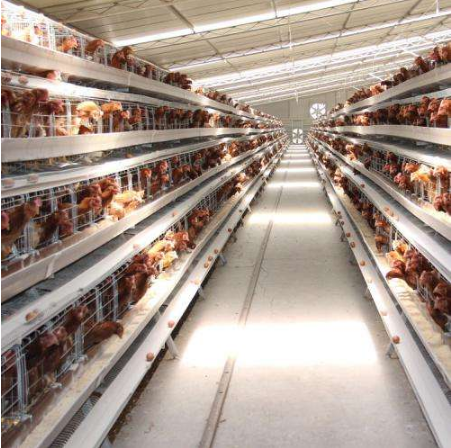The focus of the management of laying hens is to prevent heatstroke and cool down, so as to ensure that the flocks have normal feed intake and better performance.
1. Improve the environment of the house
The caged closed houses should be cooled by longitudinal ventilation. In the open house, ventilation facilities such as fans or fans should be installed to adjust the running time of the fans, shorten the ventilation interval, and make the air in the house have an ideal flow. Grasp the cool time at night and keep it ventilated. Naturally ventilated houses are to open all vents for maximum ventilation. It is recommended to install a ventilation fan in the house for forced ventilation, increase the air convection between the house and the outside world, and reduce the temperature of the house, which is more conducive to the use of the poultry battery cages.
The lawn is planted on both sides of the chicken house, and the chicken house is planted with tall trees on the sunny side. Green plants produce oxygen through photosynthesis, improving the air quality around the house. Both the greening of the chicken house and the reduction of heat radiation have been achieved.
Spraying on the roof with fixed or rotatable sprinklers, water evenly spilled on the roof, effectively reducing the temperature; in the house with the fan can be cooled by cold water spray, pay attention to keep the fan running after spraying. This method is forbidden in chicken houses without a fan, otherwise it is more likely to cause heatstroke in the flock.
Shade nets on the sunny side of the house, direct sunlight, and the air inlet of the house to avoid direct sunlight. After the air passes through the sunshade net, it cools into the house, which reduces the temperature inside the house by 2~3°C. Install insulation on the roof of the house to avoid direct sunlight on the roof, reduce the intensity of sunlight, and reduce and reduce heat radiation from the roof surface.
The water curtain is made at the door of the chicken house and the window E1 by using a water pump, and the air is cooled into the chicken house through the water curtain, so that the temperature in the chicken house is 5-6 ° C lower than the temperature outside the chicken house.
2. Strengthen the management of chicken cages
In the high temperature season, the house temperature is high, and the chicken is difficult to dissipate heat due to the absence of sweat glands. The chickens should be evacuated as much as possible to reduce the density. If conditions permit, the laying hens can be stocked in the chicken battery cages or in the free-range ground at 75% to 80% of the normal feeding amount, which can effectively reduce the small ambient temperature in the house.
Keep clean, cool, and hygienic drinking water throughout the day in the sink. It is best to use deep well water and keep it flowing. If necessary, add ice cubes to the water to lower the water temperature. In the house where the drinker is used, the water should be placed once at the end of the water pipe every 2 hours to keep the water in the water pipe cool, and the water in the nipple of the drinker should be checked frequently to prevent the chicken from being cut off.
Attention should be paid to observe the feed intake, water consumption and defecation of the chickens, and take measures in time if abnormalities are found. Timely elimination of sick chickens and inferior chickens to reduce the spread of diseases and economic losses. Cleaning, quail eggs, feeding, watering, defecation, disinfection, etc. should be light, avoid noise interference, reduce the amount of chicken movement, and prevent panic.
In the high temperature and high humidity season, the feed is prone to mildew and deterioration. The feed should be stored in a ventilated and dry place. Do not feed too much each time. It is better to eat the same day. If the feed in the trough is wet or the wet mix is fed due to water leakage from the sink, it should be timely and replenished to ensure that the feed in the trough is cleaned within 2 hours, otherwise the feed will be agglomerated. If agglomeration occurs, it should be cleared in time.
